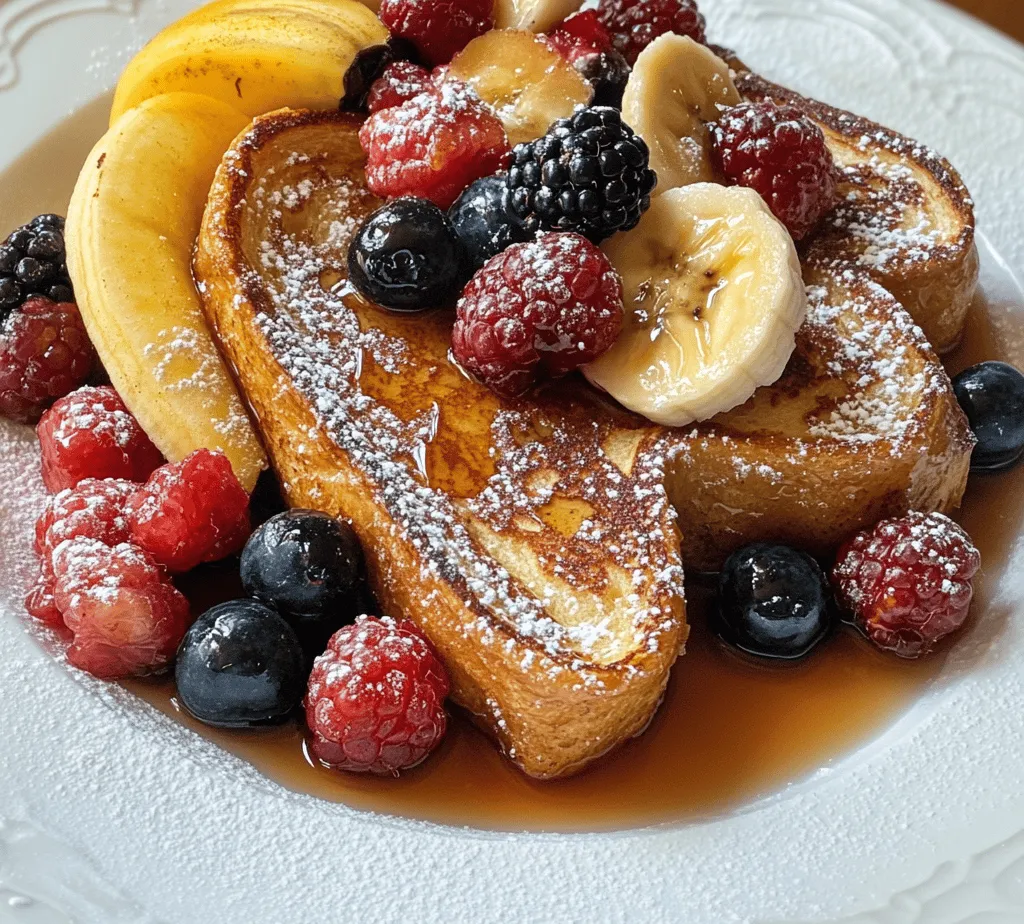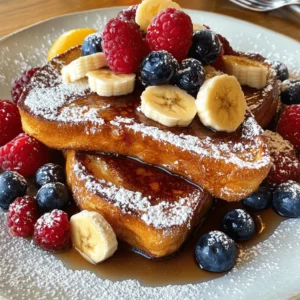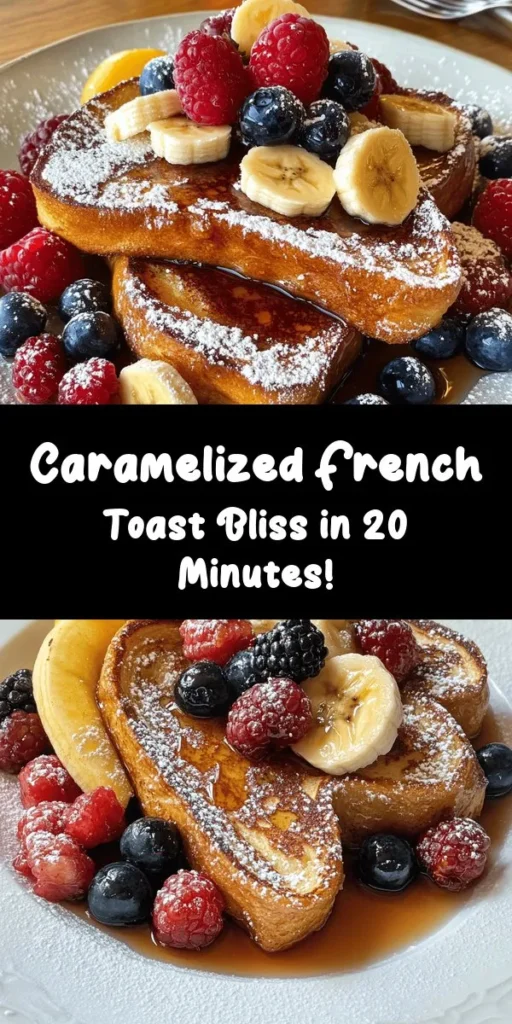Delve into the delightful world of breakfast with our Caramelized Delight French Toast, a dish that transforms the ordinary into the extraordinary. This decadent recipe, featuring thick-cut brioche or challah, is more than just a meal; it’s an experience that tantalizes your taste buds and warms your heart. The sweet, caramelized exterior paired with a soft and fluffy interior elevates this French toast to a new level of breakfast bliss. Whether you enjoy it on a lazy Sunday morning or serve it at a festive brunch, this dish is sure to impress your family and friends.
In this article, we’ll guide you through the ingredients, preparation methods, and the artistry involved in creating this scrumptious breakfast staple. You’ll learn how each component contributes to the overall flavor and texture, ensuring that every bite is as delightful as the last.
Understanding the Ingredients
The key to crafting the perfect Caramelized Delight French Toast lies in understanding the ingredients you’ll be using. Each component plays a vital role in achieving that mouthwatering flavor and texture that makes this dish so special.
Thick-Cut Bread: The Foundation of Flavor
The bread you choose is the cornerstone of any French toast recipe, and for our Caramelized Delight variation, thick-cut brioche or challah is highly recommended. Both breads are enriched with eggs and butter, giving them a rich, tender texture that holds up beautifully when soaked in the custard mixture.
Why Use Brioche or Challah?
– Texture and Taste Profile: Brioche is known for its light, airy consistency, while challah offers a slightly denser, sweet flavor. Both options will absorb the custard mixture without falling apart, ensuring a satisfying bite every time.
– Flavor Absorption: The richness of these breads allows for maximum absorption of the egg and milk mixture, resulting in a beautifully custardy interior.
Eggs: Binding and Enriching
Eggs are a crucial component in any French toast recipe, serving both as a binding agent and a source of flavor. They create a custard-like mixture when whisked together with milk and spices.
Role of Eggs in French Toast:
– Nutritional Value: Eggs are packed with protein, essential vitamins, and minerals, making them a nutritious addition to your breakfast.
– Flavor Enhancement: The richness of eggs adds depth to the custard, helping to create that irresistibly creamy texture.
Milk: The Creamy Element
Milk is another essential ingredient, adding creaminess and moisture to the batter. The type of milk you choose can affect the final texture of your French toast.
Types of Milk to Use:
– Whole Milk: This is the traditional choice, offering a rich and creamy texture.
– Almond or Oat Milk: For those seeking a dairy-free option, these alternatives work well while still providing a lovely flavor.
How Milk Contributes to the Final Texture:
Milk helps to create a smooth batter that coats the bread evenly, ensuring each slice is luxuriously soaked without becoming too soggy.
Vanilla Extract: Enhancing Aroma and Flavor
Vanilla extract is a game-changer in this recipe, elevating the overall flavor profile of your French toast.
The Significance of Quality Vanilla:
– Flavor Depth: High-quality vanilla extract adds a warm, aromatic flavor that complements the sweetness of the caramelization process.
– Alternative Flavorings: For those looking to experiment, consider adding almond extract or a splash of orange zest for a unique twist.
Cinnamon: Spice it Up
Cinnamon is a classic spice that pairs beautifully with the sweet elements of French toast. Not only does it add warmth and depth, but it also comes with health benefits.
Health Benefits of Cinnamon:
– Antioxidant Properties: Cinnamon is rich in antioxidants, which can help reduce inflammation and improve heart health.
– Using Ground vs. Stick Cinnamon: Ground cinnamon is typically used in the batter, while a cinnamon stick can be infused into the milk for a more pronounced flavor.
Brown Sugar: The Sweet Secret
Brown sugar is the sweetener of choice for this recipe, playing a crucial role in the caramelization process.
Understanding Caramelization:
– Flavor and Texture: The molasses in brown sugar contributes to a deeper, more complex flavor while aiding in the creation of a beautifully caramelized crust on your French toast.
– Brown Sugar vs. White Sugar: While white sugar can be used, brown sugar enhances the overall taste and texture, making it the preferred option for this dish.
Butter: For That Perfect Sizzle
Unsalted butter is essential for cooking your French toast to perfection. It not only adds flavor but also helps achieve that golden-brown exterior.
Importance of Unsalted Butter in Cooking:
– Flavor Control: Using unsalted butter allows you to control the saltiness of the dish, ensuring that the sweetness of the caramelization shines through.
– Contributing to the Caramelization Process: Butter helps to create that crispy, caramelized crust while also adding richness to the overall flavor.
Maple Syrup & Garnishes: The Finishing Touches
No French toast is complete without a drizzle of pure maple syrup, which adds a delightful sweetness that complements the caramelized exterior.
Choosing the Right Maple Syrup:
– Grade A vs. Grade B: Grade A syrup is lighter and sweeter, while Grade B has a stronger flavor that pairs beautifully with rich dishes like French toast.
– Ideas for Garnishing: Consider topping your Caramelized Delight French Toast with fresh fruit such as strawberries, blueberries, or bananas, and a dusting of powdered sugar for an elegant presentation.
Step-by-Step Preparation Guide
Now that we’ve explored the essential ingredients, it’s time to dive into the preparation of your Caramelized Delight French Toast. Follow these steps to craft the perfect breakfast treat.
Preparing the Batter: The Base of Flavor
1. Whisking Technique for a Smooth Batter:
In a large mixing bowl, combine the eggs, milk, vanilla extract, cinnamon, and brown sugar. Use a whisk to blend the ingredients until smooth and well combined. This step is crucial, as it ensures that the egg yolks and whites are fully incorporated, which leads to a uniform custard mixture.
2. Importance of Letting the Batter Rest:
Allow the batter to rest for about 10-15 minutes before using it. This resting period lets the flavors meld beautifully and gives the milk time to soften the sugar, resulting in a more cohesive and flavorful mixture.
3. Preparing the Bread:
While the batter rests, slice your brioche or challah into thick pieces, about 1 to 1.5 inches thick. This thickness is essential, as it allows the bread to soak in the custard without becoming overly soggy.
4. Soaking the Bread:
Dip each slice of bread into the custard mixture, ensuring that both sides are well-coated. Allow the bread to soak for a few seconds on each side; this will give it the perfect amount of moisture and flavor.
5. Cooking the French Toast:
In a large skillet or griddle, melt a tablespoon of unsalted butter over medium heat. Once the butter is sizzling, place the soaked bread slices onto the skillet. Cook for about 3-4 minutes on each side, or until they are golden brown and caramelized. Make sure not to overcrowd the pan; this allows for even cooking and browning.
As you prepare to serve this delightful dish, you’ll be captivated by the enticing aroma of caramelized sweetness wafting through your kitchen. Stay tuned for the next part of this article where we will delve into additional tips for achieving the perfect French toast and answer some common questions about this beloved breakfast treat.

Soaking the Bread: Achieving Optimal Absorption
To create the perfect Caramelized Delight French Toast, the soaking process is crucial. This step ensures that the bread absorbs the rich mixture of eggs, milk, and vanilla, resulting in a custardy texture that is simply irresistible.
Ideal Soaking Time for Maximum Flavor
The ideal soaking time for your bread can vary depending on the type of bread you use. Typically, a soaking time of 30 seconds on each side is sufficient for thinner breads like brioche or challah, which are popular choices for French toast. For thicker slices, such as Texas toast or artisanal bread, allow them to soak for about 1-2 minutes per side. This ensures that the flavors meld beautifully without compromising the structural integrity of the bread.
Tips for Avoiding Soggy Bread
To avoid soggy bread, consider the following tips:
– Use Stale Bread: Slightly stale bread is less likely to become mushy as it has less moisture to absorb.
– Dunk, Don’t Soak: Instead of allowing the bread to sit in the mixture, quickly dunk each slice into the custard mixture. This method helps to coat the bread without making it overly soggy.
– Drip Off Excess: After soaking, let the bread slices rest on a wire rack for a minute. This allows excess liquid to drip off, ensuring that the toast maintains its desired texture during cooking.
Caramelizing the Sugar: The Art of Cooking
Caramelizing sugar is a vital step that adds a rich depth of flavor and a beautiful golden hue to your French toast. The right technique will elevate your dish from good to extraordinary.
Step-by-Step on Melting Brown Sugar
1. Choose the Right Sugar: Use light or dark brown sugar for richness, as it contains molasses that enhances flavor.
2. Prepare Your Skillet: Use a non-stick skillet or griddle to prevent the sugar from sticking.
3. Heat the Sugar: Place the brown sugar in the skillet over medium heat. Stir gently as it begins to melt. It should take about 2-3 minutes to become liquid but be cautious not to let it burn.
4. Add Butter: Once the sugar melts, add a tablespoon of butter. This not only adds flavor but also helps create a luscious sauce for drizzling later. Continue stirring until fully incorporated.
Temperature Control and Safety Tips
Maintaining the right temperature is essential. Too high of a heat can cause the sugar to burn quickly, while too low won’t melt it properly. If you notice the sugar starting to smoke, reduce the heat immediately. Additionally, always use caution when working with hot sugar; it can cause severe burns.
Cooking the French Toast: Getting it Just Right
Now that your bread is soaked and your sugar is caramelized, it’s time to cook the French toast to perfection.
Optimal Skillet Temperature for Golden Results
Heat your skillet over medium heat until it’s hot but not smoking. A good test is to sprinkle a few drops of water onto the skillet; if they dance and evaporate quickly, the skillet is ready. For the best results, consider using a combination of butter and oil for cooking, as this helps achieve a nice golden crust while preventing burning.
Techniques for Flipping Without Breaking
When it comes to flipping your French toast, gentle handling is key:
– Use a wide spatula to scoop under the entire slice.
– Flip quickly and confidently to avoid tearing.
– If you’re worried about breaking, flip the toast onto a plate first, then slide it back onto the skillet, cooked side up.
Serving Suggestions: Plating for Presentation
Presentation matters, especially for a dish as delightful as Caramelized Delight French Toast. Here are some creative ideas for serving:
Ideas for Drizzling and Garnishing
– Maple Syrup: The classic pairing, drizzle warm maple syrup over the top for sweetness.
– Caramel Sauce: Enhance the caramel flavor with a drizzle of homemade or store-bought caramel sauce.
– Fresh Fruits: Top with sliced strawberries, bananas, or blueberries for a fresh and colorful touch.
– Whipped Cream: A dollop of whipped cream can add a luxurious finish.
– Nuts: Sprinkle with chopped pecans or walnuts for added crunch.
Importance of Visual Appeal in Food
Food that looks good tastes better. When plating your French toast, use a white plate to make the colors of the dish pop. Arrange the toast neatly, layer toppings artfully, and consider adding a sprig of mint for an eye-catching garnish.
Nutritional Information and Benefits
Understanding the nutritional aspects of your Caramelized Delight French Toast can help balance indulgence with health.
Breakdown of Ingredients
– Bread: A source of carbohydrates that provides energy.
– Eggs: Packed with protein and essential nutrients like vitamin D and B12.
– Milk: Offers calcium and vitamin D, contributing to bone health.
– Brown Sugar: Contains minerals such as iron and calcium, although it should be consumed in moderation.
Caloric Content Per Serving
On average, a serving of Caramelized Delight French Toast (about two slices) contains around 400-500 calories, depending on the ingredients used and the toppings added.
Nutritional Benefits of Key Ingredients
– Eggs: They are one of the best sources of high-quality protein, which is essential for muscle repair and growth.
– Milk: Provides hydration and is beneficial for skin health due to its vitamin D content.
– Whole Grain Options: If you choose whole grain or whole wheat bread, you’ll increase fiber intake, which is great for digestive health.
Balancing Indulgence with Health
While this French toast is a treat, there are ways to make it healthier without sacrificing flavor:
Tips for Making the Dish Healthier
– Use Whole Grain Bread: Opt for whole grain or multigrain bread for added fiber and nutrients.
– Reduce Sugar: Cut back on the amount of sugar used in the custard mixture or choose a sugar substitute.
– Add Fruits: Fresh fruits not only add flavor but also vitamins and antioxidants.
Suggestions for Portion Control
To enjoy this delicious recipe while maintaining portion control, consider serving smaller portions with a side of fresh fruit or a light yogurt to balance the meal.
Occasions for Caramelized Delight French Toast
This versatile dish fits perfectly into various occasions, making it a favorite for many.
Perfect for Weekend Brunches
French toast is synonymous with brunch, and there’s no better way to enjoy a leisurely Saturday or Sunday morning. Pair it with coffee or a mimosa for the ultimate brunch experience.
Celebrating Special Occasions
Caramelized Delight French Toast can elevate any holiday breakfast or celebration. Consider serving it during festive gatherings, birthdays, or family reunions, where it can be a centerpiece dish.
Creating a Memorable Breakfast Experience
The combination of flavors, textures, and visual appeal makes this French toast perfect for creating memorable breakfast experiences. Engage your guests with a DIY toppings bar, allowing everyone to personalize their toast.
Quick Weekday Breakfast Option
For busy mornings, this dish can be made in advance. Soak the bread the night before and store it in the refrigerator. In the morning, simply cook it on the skillet for a quick, delicious breakfast.
Time-Saving Tips for Busy Mornings
– Prep Ahead: Prepare the custard mix and store it in an airtight container in the fridge.
– Batch Cooking: Make a larger batch over the weekend and reheat slices in the toaster or microwave during the week.
Conclusion: Embracing the Joy of Homemade French Toast
In summary, the Caramelized Delight French Toast is more than just a breakfast dish; it embodies the warmth of home-cooked meals and the joy of sharing food with loved ones. With its simple yet sophisticated flavors, this recipe invites you to savor the moment, whether you’re indulging on a leisurely morning or serving it at a festive gathering. By following this comprehensive guide, you can master the art of French toast and create a beloved dish that will have everyone asking for seconds. Embrace the delicious possibilities that come with every slice and enjoy the sweet rewards of your culinary efforts.



